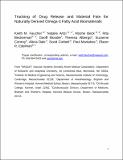Tracking of Drug Release and Material Fate for Naturally Derived Omega-3 Fatty Acid Biomaterials
Author(s)
Faucher, Keith M.; Artzi, Natalie; Beck, Moshe; Moodie, Geoff; Albergo, Theresa; Conroy, Suzanne; Dale, Alicia; Corbeil, Scott; Martakos, Paul; Edelman, Elazer R; Beckerman, Margarita; ... Show more Show less
Download10439_2015_1489_ReferencePDF.pdf (1.374Mb)
OPEN_ACCESS_POLICY
Open Access Policy
Creative Commons Attribution-Noncommercial-Share Alike
Terms of use
Metadata
Show full item recordAbstract
In vitro and in vivo studies were conducted on omega-3 fatty acid-derived biomaterials to determine their utility as an implantable material for adhesion prevention following soft tissue hernia repair and as a means to allow for the local delivery of antimicrobial or antibiofilm agents. Naturally derived biomaterials offer several advantages over synthetic materials in the field of medical device development. These advantages include enhanced biocompatibility, elimination of risks posed by the presence of toxic catalysts and chemical crosslinking agents, and derivation from renewable resources. Omega-3 fatty acids are readily available from fish and plant sources and can be used to create implantable biomaterials either as a stand-alone device or as a device coating that can be utilized in local drug delivery applications. In-depth characterization of material erosion degradation over time using non-destructive imaging and chemical characterization techniques provided mechanistic insight into material structure: function relationship. This in turn guided rational tailoring of the material based on varying fatty acid composition to control material residence time and hence drug release. These studies demonstrate the utility of omega-3 fatty acid derived biomaterials as an absorbable material for soft tissue hernia repair and drug delivery applications.
Date issued
2015-10Department
Massachusetts Institute of Technology. Institute for Medical Engineering & Science; Harvard University--MIT Division of Health Sciences and TechnologyJournal
Annals of Biomedical Engineering
Publisher
Springer US
Citation
Faucher, Keith M., Natalie Artzi, Moshe Beck, Rita Beckerman, Geoff Moodie, Theresa Albergo, Suzanne Conroy, et al. “Tracking of Drug Release and Material Fate for Naturally Derived Omega-3 Fatty Acid Biomaterials.” Ann Biomed Eng 44, no. 3 (October 26, 2015): 782–792. doi:10.1007/s10439-015-1489-y.
Version: Author's final manuscript
ISSN
0090-6964
1573-9686